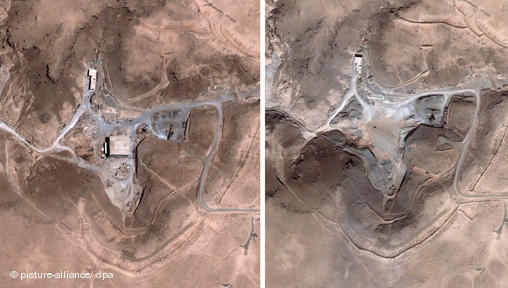|
|
|
Satellite imagery showing a suspected nuclear facility in Syria before and after being destroyed by an Israeli airstrike. Image from Deutsche Welle. |
In the midnight hours of Sept. 5, 2007, 10 Israeli F-15 fighter jets departed from Ramat David Air Force Base in southeast Haifa with a mission to destroy a mysterious military complex in the middle of the Syrian desert. Eighteen minutes later, the complex at Dair Alzour was demolished-Operation Orchard was a success. Was the complex an initial Syrian attempt to construct a nuclear reactor, as claimed by the Israelis, or was it merely, as the Syrians maintain, a simple conventional weapons factory?
Yesterday, the International Atomic Energy Agency (IAEA) released an updated report on the “Implementation of the NPT Safeguards Agreement in the Syrian Arab Republic.” This report, written by IAEA Director General Yukiya Amano, describes the test results from an IAEA inspection visit of the rubble in June 2008. The following findings are significant:
• The site infrastructure was outfitted with “adequate pumping capacity of cooling water [that is] similar to what may be found at nuclear reactor sites.”
• Large quantities of graphite and barium sulphate were found (Syria claims that these chemicals were acquired for civilian, non-nuclear use).
• The presence was noted of “anthropogenic (chemically processed) natural uranium of a type not included in Syria’s declared inventory of nuclear materials.” (Syria maintains that these particles were the vestiges of the Israeli missiles and bombs used to destroy the complex.)
Since the IAEA’s visit to Dair Alzour in the summer of 2008, the Syrian government has not cooperated with inspectors in answering further lingering questions about the purpose of the now-destroyed complex. The Assad government refuses to allow international inspectors to run tests on debris from the site and will not explain how Syria obtained the anthropogenic uranium. Currently, the Syrian government has not reported any national inventory of natural uranium to the IAEA.
For their part, the Israelis have withheld many specific details about the implementation of Operation Orchard. Without these details, the IAEA is unable to determine whether trace amounts of uranium could exist in the rubble of the complex at Dair Alzour without its having been used as a covert nuclear enrichment site.
Based on the environmental report conducted by the IAEA (and the Syrian government’s obstruction of further investigation), it is not unreasonable to assume that the Syrians were in the nascent stages of enriching uranium in the fall of 2007. The Israelis’ preemptive strike-which resembled their attack on Iraq’s Osirak reactor in 1981-may well have prevented the Syrians from joining the Iranians in their race to become the next nuclear power on the world’s stage.
Are you a dedicated reader of FDD's Long War Journal? Has our research benefitted you or your team over the years? Support our independent reporting and analysis today by considering a one-time or monthly donation. Thanks for reading! You can make a tax-deductible donation here.








